Endgame Studies
Click here to go back to the Study Page or the Home Page
![]() "The whole of chess can
be viewed merely as an endgame study on the grand scale". - Richard Réti
"The whole of chess can
be viewed merely as an endgame study on the grand scale". - Richard Réti
To my mind, endgame studies are to chess games what string quartets are to symphonies. They represent the triumph of the small over the large.

Richard Réti was born at Pezzinok near Bratislava on May 28th 1889. In his youth mathematics and Chess were his twin passions. Eventually it was the latter which gained the upper hand: "paradoxically enough I considered chess more alive than mathematics". He considered modern mathematics to be of a purely speculative character whereas in Chess with its over the board struggle he could force his opponent to acknowledge the truth of his chess ideas. As a young, aspiring player he was much influenced by Julius Breyer who like him, was to die tragically young. Just after the end of the First World War he won first prize at Kaschau (Kassa) in a field that included Vidmar, Breyer, Aztalos, Havasi and Mieses. He shared first place at Budapest in the same year, was first at Rotterdam 1919, Amsterdam and Vienna, 1920, and, above all, won first prize at the great international tournament of Gothenburg 1920. In 1921 he became less active as a player because he started writing-he became a journalist and a chess author. During this period he wrote Modern Ideas in Chess. He returned to the chess arena the following year. He was first equal at Teplitz-SchÖnau; in 1923 he was second twice at Mährisch-Ostrau and Vienna; in 1924 he achieved his famous win over Capablanca (the Cuban's first loss in seven years!) in the New York tournament. He then went to South America where he established a new world blindfold simultaneous record: at Sao Paulo in Brazil, on February 7th 1925 he played 29 games, won 20 drew 7 and lost 2. In 1925 he returned to Europe where for a time his results were a little disappointing. However, at the great Moscow tournament of 1925 he finished seventh out of twenty-one and won a beauty prize for his win against Romanowski. In the same year he also married.
From now on he was actively engaged in creating his famous endgame studies which include in their number (he composed just over 50) some of the finest ever composed. According to Tartakower Reti said that "the whole of chess can be viewed merely as an endgame study on the grand scale". In 1927 at Bad Homburg he was second. In 1928 he was first at Vienna and Giessen, second at Dortmund and first equal at Brno. Towards the end of the year he went to Scandinavia for a prolonged tour. His last tournament was at Stockholm, a double-round event player from December 23rd, 1928 to January 30th, 1929. Reti finished first ahead of Lundin, Stolz and Stahlberg. Returning home after a busy schedule of simultaneous displays in Norway and Sweden, he busied himself with the preparation of his next great book, Masters of the Chessboard, but he did not live to complete it. He fell ill with scarlet fever and died in a Prague hospital on June 6th 1929, at the age of forty.
He was not just a chess master and a chess author, but a poetic and intellectual artist who just happened to have chosen chess as the medium for his ideas. For the sake of the idea, he was willing to sacrifice success, not only as it is known to the outer world away from chess, but even to chess players themselves in the form of tournament or match triumphs. As his brother, Rudolph Réti was to put it: "...[my brother] was always more interested in the creative aspects of this Art of Chess than in merely winning the game." Amongst his friends their circulated stories of his absent mindedness, to quote Tartakower again: "He forgot everything, stick, hat, umbrella; above all, however, he would always leave behind his traditional yellow leather briefcase, so that it was said of him: wherever Réti's briefcase is, there he himself is no longer to be found. It is therefore evidence of Réti's pre-existence." In chess his abiding passion was strategy, and it was here he made his greatest contribution to the chess world. In his obituary of Réti that appeared in L'Echiquier Spielmann wrote: "Perhaps his strength did not reside so much in the discovery of a new move or a tactical finesse hitherto unknown as in a new strategy. Very frequently and after a few moves, I would find myself settling down against him with a lost position without knowing exactly how it could possibly have happened."
A significant light on his character can be revealed by the following extract of an article Réti wrote in an edition of Morgenzeitung, 1929. He was annotating a game from Russia in which the following position was reached.
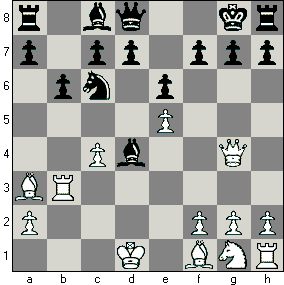
Lukomski (to play) - Pobedin
Here White played 12.Qg7+, and Réti remarked: "Something like this is not only pretty, but has the advantage of being much easier to understand than a difficult positional game. Thus it is only natural that the greater part of the chess world should be displeased with the fact that one seldom sees anything similar happening in modern master tournaments. But the blame should be laid, not on the masters, but on the tournament organizers. The latter must decide to invite to great-master tournaments some Pobedins as well. Then the public would see so many sacrificial combinations of this type that they would soon find them as banal and uninteresting as the writer of these lines-please forgive me for this confession-finds this Queen sacrifice". [my italics].
This article is based on an original memoir written by Harry Golombek
**************************************
Click here to go back to the top of this Page, Study Page or the Home PageA selection of Richard Réti's Endgame Studies
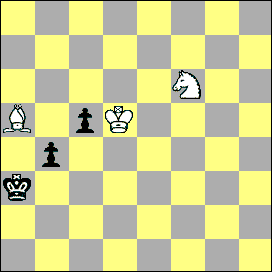
White to play and win.
Solution: Careful! This one is more difficult than it looks. Most club players would intuitively want to move the White King towards the Black pawns rather than away from them. But 1.Ke4! Not obvious; White takes action to avoid stalemating his opponent. 1...b3 2.Nd5 g2 3.Nc3 Kb3 4.Kd3 and wins. Other first moves by White enable Black to draw. So, if 1.Ne4 g3 2.Kc4 g2 3.Nc3 b1=Q 4.Nb1+ Ka4 5.Any Bishop moves, and Black is stalemated!! Likewise, if 1.Kc4, the most 'natural' looking move, 1...g3 2.Ne4 g2 we enter into the same variation as above. So, if White moves his King to close to its opposite number too quickly he allows Black to escape (well, not to escape would be more accurate). How many club players would notice that? I mean if the White King goes to square c4 immediately it is by no means clear, at least to me, that his opponent's King is deprived of escape squares. Of course once you know the solution it becomes an easy matter to 'see it'.

White to play and win.
1.Kf5! 2.Be2 3.Kf4, and Black is in zugswang. If the Bishop moves off the f1-a6 diagonal White will play a5 and b6, and if it the moves off the d1-h5 diagonal White will play h5. Any moves from the Black King takes it too far away from the Q-side pawns, so that White will play Kg5 and force the h-pawn forward. Black will be forced to sac his Bishop leaving White free to promote one of his Q side pawns.
If 1...Ke3 2.a5 Kd4 3.b6 ab6 4.ab6 Kc4 5.Kf4 Bd5 6.Ke3! Bc6 7.h5, and once again the Bishop has too much work to do.
If 1...Kg3 2.Kg5 Be2 3.h5 Kf2 4.h6 Bd3 5.a5 now it's zugswang again. But there is also one for the defence! If White plays 1.Kf4, then 1...Be2, now White is in zugswang himself! Any pawn move loses a pawn, whilst if 2.Ke4 Kg3, and if 2.Kg5 Ke3. Completely unexpected. Perhaps one of Reti's less spectacular studies but, as usual, full of subtleties. The theme of zugswang is a prominent feature which, given the open nature of the position, is surprising.
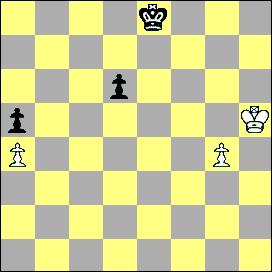
White to play and win.
1.Kg5 Kf7 2.Kf5 Ke7 3.Kg6 Ke6 4.g5 wins since the g-pawn promotes with check before Black's d-pawn touches down. If 3...d5 4.Kf5 Kd6 5.g5 wins since, Black's d-pawn promotes one move after White's g-pawn after which White wins the new Black Queen by checking on square d8. If, after 5.g5, the Black King goes after White's g-pawn the White King will snap up Black's a-pawn and Black's King won't be able to get back to square a8 to draw in time. As usual Reti shows that the more precipitate approaches both fail. Namely, if White goes after Black's d-pawn straight away by: 1.Kg3 Ke7 2.Kf5 Kf7 3.Ke4 Kg6 4.Kd5 Kg5 5.Kd6 Kg4 6.Kc5 Kf5 (here, it still looks as if White will triumph) 7.Kb5 Ke6 8.Ka5 Kd7 9.Kg6 Kc8 10.Ka7 when White won't be able to force the a-pawn through. Finally, if White tries to force his g-pawn home by 1.Kg6 Ke7 2.g5 d5 3.Kh7 d4 4.g6 d3 5.g7 d2 6.g8=Q d1=Q draws. Sheer calculation in these kinds of positions is hard work. Sometimes, as in the last variation, just 'counting moves' will show that the direct method just isn't effective. I suppose the club player just has to rely on the general principles we hear so much about but which few of us, I suspect, spend too much time on. This study, by the way, published in the Berliner Tageblatt, 1923 was dedicated to the memory of Julius Breyer.
Click here to go back to the top of this Page, Study Page or the Home Page

White to play and win
Black's menacing pawns suggest that White will have to act quickly, Reti shows that this is not so. 1.Ke1! g3 2.Nd2 g2 3.Nf3+ Kg3 At first I wasn't sure what happens after 3...Kh1 but I think it goes as follows: 4.Kf2 h2. If 4...g1=Q 5.Ng1+ and 6.Bc8. 5.Bc6! White now just needs to 'pass' twice to win. Obviously 5.Nh4?? is a draw. 5...h3 6.Bd5 g1=Q 7.Ng1++. 4.Ng1 h2. Or 4...Kg4 5.Bc8+ and Bh3. 5.Ne2+ Kh3. Otherwise 6.Bg2. 6.Bc8++. Here if 2...Kg1 3.Nf3+ Kg2 4.Bc6 Kh1. Or 4...h2 5.Ng5+ Kg1 6.Nh3++ 5.Kf1 g2+ 6.Kf2 h2 7.Ne1 h3 8.Ng2 gh3 9.Bh3++. If 1...Kg1 2.Nc3 h2 3.Ne2++. It's this last line that reveals the reason for 1...Ke1!; square e2 must be vacated for the Knight. At the same time White must ensure that the squares f1 and f2 are denied to the Black King.
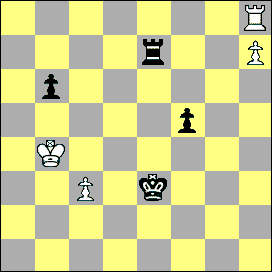
White to play and win
1.Kb5 f4 2.Kc6! If 2.Kb6 f3 leads to a draw. 2...Kf2. 2...f3 3.Kd6 f2 4.Ke7 f1=Q 5.Rf8 wins! 3.Kb6 With the Black King on the f-file only now does White take the b6 pawn 3... f3 4.Kc6. Not 4.c4 Ke2 5.Kc6 f2 6.Kd6 Rh7! Of course much stronger than 6...f1=Q 7.Ke7. How will Black stop White's h-pawn from queening? 4...Rf7. Here 4...Ke2 5.Kd6 leads to a similar variation to that given in the first note. Or if 4...Kf1 5.Rf8 wins immediately. 5.Kd6. Other moves allow Black to play Kf1, for example: 5.c4 Kf1 6.c5 f2 7.Kd6 Rf6+ 8.Kd5 Ke1 9.Re8+ Kd2 10.h8=Q f1=Q 11.Qh2+ Kc1. 5...Rf6+. Now 5...Kf1 can be met by 6. Ke6, and if 5...Ra7 6.c4 Kf1 7.Rf8 wins. 6.Kd5 Rf5+ 7.Ke6 Rh5. Or 7...Rf4 8.Rc8. 8.Kd6. White now starts to move his King to the Q-side to avoid the Rook checks. It's a draw after 8.c4 Ke3 9.Kd6 Kd4. 8...Rh6+ 9.Kc5 Rh5+ 10.Kb4. Now White can fend off the Rook checks and wins by advancing his c-pawn. Phew!! Very involved. This is a quite a hard rook and pawn ending to understand and should be played through several times.
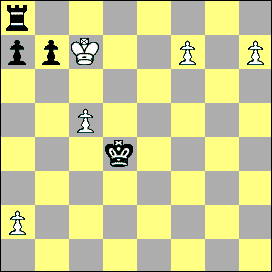
White to play and win
1.Kd7. With the threat of Ke7-f6-g7. 1...Rh8 Black has no time for 1...Kc5. 2.Kd6. If 2.Ke7 Rh7 and Black wins. At first sight this looks crazy doesn't it? What's wrong with 2.Ke6 and then Kf6-g7? Surely that must win. Well, you might think so, but Reti is a magician. All is revealed in the next note! 2...Kc4 3.c6! bc6 4.Ke5!! Threatening Kf6-g7. 4.Ke6? is a mistake; Black plays 4...Kc5. Now the 'a' pawns can advance but White must move his King. If 5.Kf6 Kd6 6.Kg7 Ke7! 7.Kh8 Kf7! is a draw. Fantastic isn't it? I told you that Reti is a magician! Or if 5.Ke5 Rb8 6.Kf6 Kd6 7.Kg7 Ke7 and Black wins. Beautiful! Every tempo counts. 4...Kc5. Stopping White from playing 5.Kf6 because of 5...Kd6. But now 5.Ke6! Wins because Black is in zugswang. Both sides advance their 'a' pawns. If Black moves his King, White wins by Kf6, since now the Black King will be too far away for the above stalemating maneuver to work; if the Rook moves, say, 5...Rb8 White wins by 6.Ke7 Rb7+ 7.Kf8 Rb8+ 8.Kg7. One further nice point is that 1.Kd6 doesn't work due to 1...Rh8 2.c6 bc6 3.Ke6 Kc5, and again White finds himself in zugswang: 4.Kf6 Kd6 5.Kg7 Ke7. Everything works like the intricate mechanism of a Swiss watch. For this study Reti won first prize in the Schachmatny Listok, 1927.
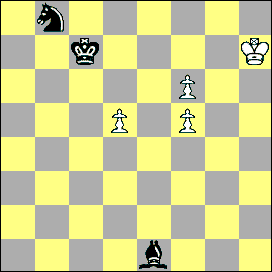
White to play and draw
1.d6+ Kd6 2.f7. Not 2.Kg7 Bc3. 2...Nd7 3.Kg7 Bc3+ 4.Kg8. Now if 4...Ke7 5.f8=Q Nf8 6.f6+ Bf6. 6...Ke8 7.f7+ leads to the same outcome. Stalemate! Or 4...Nf6+ 5.Kg7 Ng4+ 6.f6 Bf6+ 7.Kg6 Be7. 8.Kg7 Bf6+ 9.Kg6 Ke7 10.f8=Q+ Kf8 11.Kf5 wins a piece.
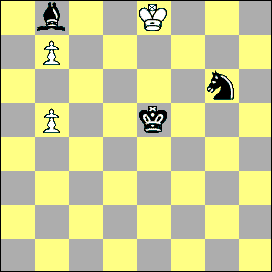
White to play and draw
1.Kd8 Bd6 2.Kd7! Kd5. The only way to progress but crucially it deprives the Knight of an important square. If here: 2...Ne7 3.b8=Q, or 2...Nf4 3.Kc8. 3.Kc8 Ne7+ 4.Kd7 draws. Why not 1.Kd7 at once? This is just not precise enough (at least not for Réti, it isn't!) He cleverly, demonstrates that this would lose after 1...Bd6 2.Kc8 Ne7+ 3.Kd7 Nd5! 4.Kc8 Nb6+ 5.Kd8 Ke6 6.Ke8 Bc7 etc.,
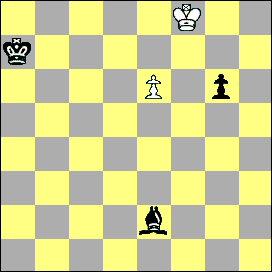
White to play and draw
1.Ke7 g5 2.2.Kd6 g4 There are surely many club players who would seriously consider resigning here. 3.e7 Bb5 Notice how the King now uses the opposing Bishop to 'assist' it to get back into its own half of the board in time to stop the 'g' pawn. 4.Kc5 Be8 5.Kd4 Kb7. Or 5...g3 6.Ke3 g2 7.Kf2 Bc6 8.e8=Q 6.Ke4 Kc7 7.Kf4 Bh5 8.e8=Q draw.
Click here to go back to the top of this Page, Study Page or the Home Page
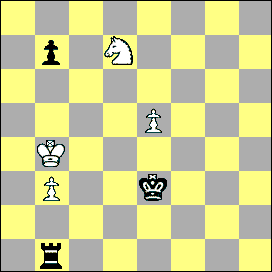
White to play and win
A rarity for Réti an endgame study: Knight v Rook. 1.e6 Re1 2.Ne5 and if the King moves off the e-file Black loses his Rook! If 2...Rd1 3.e7 of course, or 2...Rh1 3.Nf7 Re1 4.e7 again. If 1...Ra1 2.e7 Ra8 3.Nf6. If 1...Kd4 2.Ne5 Ra1. 2...Ke5 3.e7. 3.e7 Ra8 4.Nf7 Re8. Otherwise 5.Nd8. 5.Nd6 Re7 6.Nf5+. Finally, if 1...Kf4 2.e7 Re1 3.Nf6 Re7 and another Knight fork 4.Nd5+. Nice!
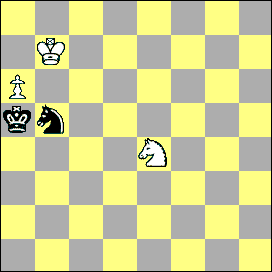
White to play and win
1.Nc5 Kb4 2.Kb6 Nd6 3.Ne4! Nc8+ 4.Kc7 Kb5 5.Kb7 Ka5 6.Nc5 Nd6+ 7.Kc7 Nb5+ 8.Kc6 Na7+ 9.Kb7 Nb5 10.Ne4. Turning full circle! We are back to the original position but this time with Black to play! 10...Kb4. If 10...Ka4 11.Nc3+! 11.Kb6 Kc4 12.Nc3! and wins.
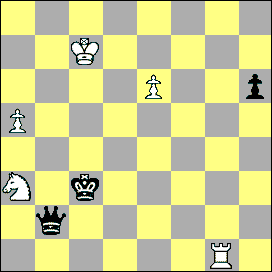
White to play and win
1.e7 Qe2 2.Rg3+ K moves 3.Re3! Qe3 4.Nc2 or Nc4 wins the Queen. If instead 1...Qh2+ 2.Kc6 Qe2. If 2...Qe5 3.Rg3+ Kb4 4.Nc2+ Kc4. 4...Ka5?? 5.Ra3++. 5.Ne3+ Kb3 6.Nd5+ followed by 7.Re3. In this variation if, 3...Kd4 4.Nb5+ followed by 5.Nd6+ 3.Nb5+ and now if: 3...Kd2 4.Rd1+! Kc2 4...Kd1? 5.Nc3+. 5.Nd4+, or 3...Kd3 4.Rd1+ Kc4 5.Nd6+, or 3...Kb2 4.Rb1+! followed by a fatal Knight fork next move, or 3...Kb4 4.Rg4+! Ka5 5.Ra4+ and 6.Nc3+, or 3...Kc4 4.Nd6+. It is quite extraordinary how the Knight overpowers the Queen in all variations.
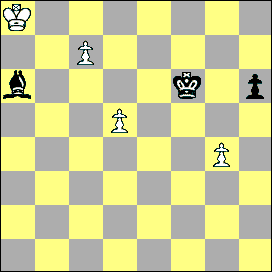
White to play and draw
1.d6 Ke6 2.d7 Kd7 3.Ka7 Be2. 3...Kc7 4.Ka6 and White's King heads toward the drawing square h8. 4.Kb8 Ba6 5.Ka7 Bf1 6.Kb8, and draws since Black must repeat moves. Note that White would lose after an inversion of moves by 2.Ka7 Bc8 3.d7 Bd7! or 3.Kb8 Kd7. Not one of Réti's best studies, but I include it because it was the very last study he composed shortly before his untimely death in April, 1929.
Although I've tried my best to eliminate any errors on this page if you find any I would appreciate it if you could send me an email about it at felixstowechess@lycos.com.
Click here to go back to the top of this Page, Study Page, Home Page
![]()